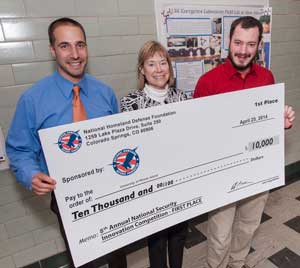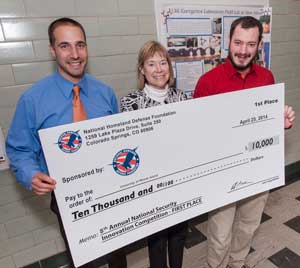 KINGSTON, R.I. – June 11, 2014 – A Cranston resident pursuing his doctorate in chemistry at the University of Rhode Island captured first place in the eighth annual National Security Innovation Competition.
KINGSTON, R.I. – June 11, 2014 – A Cranston resident pursuing his doctorate in chemistry at the University of Rhode Island captured first place in the eighth annual National Security Innovation Competition.
Jonathan Canino gave a talk and presented a poster on “Safe Training Aids for Bomb-Sniffing Dogs” during the late-April event in Colorado Springs sponsored by the National Homeland Defense Foundation. Canino’s presentation was based on years of research by URI Chemistry Professor Jimmie Oxley, co-director of the Department of Homeland Security Center of Excellence in Explosives and those who have worked on her team. URI’s first-place entry earned a $10,000 check from the defense foundation.
Canino’s first-place finish marked the third national title captured this spring by URI students in three separate contests. In early April, Bianca Peixoto was crowned champion at the National Collegiate Soils Contest, as she defeated students from 18 other universities from around the country. URI computer engineering students and their autonomous model race car took first place in a national competition and will represent the United States in the upcoming world championships. The car completed the course in 17.7 seconds, faster than 27 other teams at the annual Freescale Cup in Rochester, N.Y.
Canino’s presentation competed with those of the Florida Institute of Technology, Indiana University and the U.S. Air Force Academy. Other finalists were: Colorado Technical University, Saint Louis University, University of Wyoming and two additional United States Air Force Academy teams.
“We were surprised and pleased,” Oxley said. “A number of students have worked on this project over the last decade, in particular, former URI doctoral student Evan Bernier. Jon has perfected the third generation of these training aids. I am hoping the next student will see it to the marketplace. We’re almost there.”
“This year’s competition was truly unprecedented,” said Lt. Gen. Ed Anderson, president of the National Homeland Defense Foundation.
According to the foundation’s news release about the contest, this was the broadest range of technological innovations ever presented, and all were relevant to the homeland security and defense sectors.
“The National Homeland Defense Foundation feels confident in the future of our homeland security and defense infrastructure after seeing the types of technologies presented,” said Anderson. “These students are the future workforce and are already developing amazing innovations.”
For at least 10 years, Oxley, a world-renowned expert on explosives, pyrotechnics and explosives, has been working with her students to develop safe portable aids to train bomb-sniffing dogs. She has worked most extensively with K-9 Unit of the Metropolitan Transportation Authority Police Department in New York, but has also worked with dogs from the Rhode Island and Massachusetts bomb squads. Oxley and her team have been working with the New York transit police to develop training aids to help dogs detect peroxide-based explosives. Because they are hazardous and dangerous to transport, it is impossible to train dogs with bulk quantities. Oxley’s team has developed training aids with traces of these explosives that pose no explosion hazard.
The research process started with putting small amounts of explosive on cotton balls. Refinements led to the use of clean filter paper coated with a thin layer (400 to 600 micrograms) of explosive. The newest refinement, presented by Canino in Colorado, involves the use polycarbonate microspheres (diameters of about 90 microns). In simple terms, these are mostly plastic spheres with a small amount of explosive. The advantage is they can be stored for long periods of time, and only become activated when heated.
“Think of it this way,” said Canino. “It’s like having a plastic lid on a container, and the only way to release the lid or take it off is to heat it up.”
The Cranston resident, who earned his bachelor’s degree at URI, has been working on the project for about seven years, including five years on the microspheres.
In its eight years, the National Security Innovation Competition has grown from a Colorado-only university competition to an internationally recognized national security, science, technology, engineering and mathematics (STEM) education program.
The overall goal of the National Security Innovation Education Program is to educate students about the need and desire for a more robust STEM workforce, to motivate students to pursue related degree programs and/or career paths, and to give students incentives, through scholarship dollars and other opportunities, to follow this pathway to restore STEM expertise, innovation and technological superiority of the United States and its allies.
Pictured above
CHAMPIONSHIP CHECK: Cranston’s Jonathan Canino, at right, who captured first place in a national competition for his talk and poster titled “Safe Training Aids for Bomb-Sniffing Dogs,” poses with University of Rhode Island Chemistry Professor Jimmie Oxley, center, and Even Bernier, a former graduate student of Oxley’s, with the winning check. URI Photo by Michael Salerno photography.

